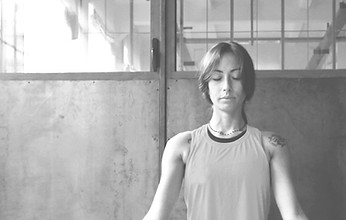Milan, 22 September 2020
The main reason we start practicing yoga is often to find some form of liberation from daily stress — the pressure of obligations, conditioning, and the boundaries of the society we live in. At first, we experience release and wellness through the practice. But at some point, many of us feel demotivated by the limits and conditions we also encounter within the way yoga is taught. As we go deeper, we might find ourselves facing the same constraints we were trying to escape: too much focus on form, an impersonal system that suppresses self-expression, and a dogmatic sense of judgment.
We hear things like:
“if you don’t practice six days per week, it’s not yoga,”
“if your hips aren’t square, it’s wrong,”
“if you don’t honour a guru, you’ll get lost,”
“if you eat animals, you can’t be a yogi.”
And so on.
Leveza is a Portuguese word that means lightness.
This is how I approach the magical science of yoga — with lightness, curiosity, and openness.
Even if I personally don’t relate to eating meat, or to practicing only once in a while, or to the absence of a guide — I want to keep my eyes open and see yoga beyond all forms.
I propose a lighter and freer way to live the practice, grounded in understanding and respect for all possible paths, timings, and experiences.
I teach the practice with its rules and systems, always remembering that these structures exist to support us in the beginning — but they have a limited nature in the process of self-liberation.
We can’t stay bound to them forever.
Rules are meant to guide us toward deeper self-listening, not to replace it.
Discipline and commitment are essential, but they are only the first steps.
What truly shapes the yoga path is connection with a guide, embodiment of a structure, listening deeply, slowing down, and cultivating loving understanding.
The side effects? Flexibility, faith, creativity, softness — and lightness.
Students are not asked to belong to a single community, a specific style, a strict diet, or a cultural identity.
In the end, yoga is one practice, one asana, one humankind, one love.
You might call it Kundalini or Ashtanga, Pranayama or Breathwork, Iyengar or Postural Yoga, Niyamas or ablutions, Ekadashi or intermittent fasting — it’s all the same essence, expressed through different languages.
Whether you go fast or slow, whether you’re caught in the ego triggers of the system or walk humbly, we are all searching for the same experience: Liberation.
We practice to find freedom from the burden of the self — the scared, ashamed self shaped by conditioning.
And sometimes, liberation itself means being free from the idea of Liberation — realizing that even this identity is just a game of consciousness, a dance of the soul.
An Invitation to Explore
Students are encouraged to:
-
explore different teachers and traditions, especially those focusing on the mechanics of the breath, with compassion and kindness;
-
consciously enjoy their own humanity and ideals, noticing where conditioning appears — and where true listening begins.
Learn from traditions, then create your own.
From Idealised Enlightenment to Embodied Interconnectedness
Even these intelligent and magical practices of liberation can suffer from a common conditioning: perfectionism.
So often, our intense search for techniques and alignment becomes a burden — tied to the idea of form.
To me, alignment exists in the dialogue between forces, not in appearance — as long as there’s no effort or pain.
Alignment is balance, expressed through connection, communication, and union of the parts and energies involved. Like in any relationship, sometimes one side gives more than the other — and that’s safe, as long as we know it’s not always going to be that way. Other times, the balance shifts.
As long as we feel this natural loving and lively dialogue, that connection is alignment — even if it looks dis-aligned from the outside.
There’s a deeper need to cultivate compassion, rather than mastery.
You'll find me there.
Namasté.
Carolina


